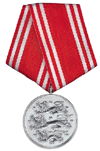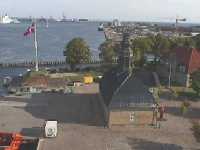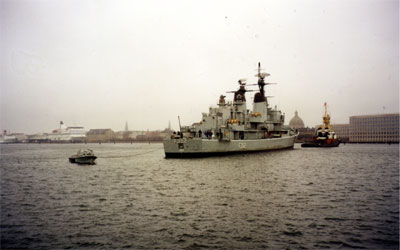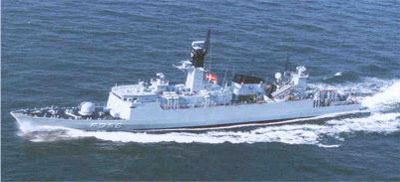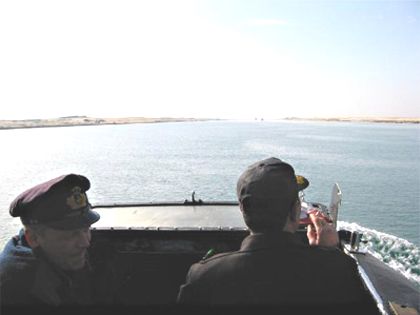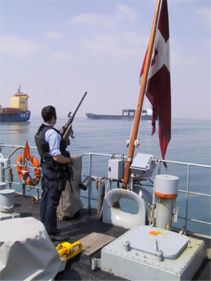|
You are here: 4Campaigns & Battles4Index4The Navy after 1989 |
||||||||||||||||||||||||||||||||||||||||||||||
|
The Navy after 1989:End of the Cold War opened up for New International Tasks
The Navy on new and big
international tasks after 1989. The 90'ties and the beginning of the new millennium led the Navy to new international tasks including the biggest maritime involvement outside Denmark in recent times. The Cold War was barely over when the corvette OLFERT FISCHER was sent to the Persian Gulf to participate in a UN-action against Iraq. Some 10 years later the corvette yet again headed towards the Gulf together with the submarine SÆLEN this time as Denmark’s contribution to the war against Iraq. 3 corvettes, 1 submarine and several units of the FLYVEFISKEN Class have been part of Denmark's biggest contribution to international operations in recent years, the culmination being SÆLEN and OLFERT FISCHER's participation in the multinational forces against Iraq. By Johnny E. Balsved/translated by Susanna Graabaek On April 4, 1989 NATO celebrated its 40th birthday with the clear expectation of a world in change. The fall of the Berlin Wall in November, 1989 signified to many the end of the Cold War. At the same time the disintegration of the Soviet Union and the disbandment of the Warsaw Pact meant that former enemies now became friends. A nearly 45 year old concept of an enemy was rapidly changing, the world was no longer divided into an east and a west and the Navy faced new international tasks. When Iraq invaded Kuwait in the beginning of August 1990 the corvette OLFERT FISCHER participated in the annual exercise DANEX (90) together with the rest of the fleet. Everybody followed with rising tension what was developing in the Middle East and few probably had imagined that this corvette would be on its way towards the Persian Gulf just one month later. A Change in Danish Security- and Foreign Policy On August 31, 1990 the Danish Parliament made a historic decision which at the same time was a clear change in the Danish Security- and Foreign Policy pursued till now. The decision of the Danish Parliament was very concise:
The decision was a direct follow up on the invasion of the neighboring country Kuwait by Iraq at the beginning of August, 1990 and with that the formal basis was established for deploying the corvette OLFERT FISCHER.
the nation, venturing out on an expedition which would take them more southerly than any Danish warship had been in the recent 90 years. The operation was codenamed FARAWAY and the expedition was to last one year and 3 days. With the deployment of the corvette the Royal Danish Navy embarked on its new international role, a role which were to mark the following many years. New Off Shore Patrol Frigates On July 1, 1991 the first of the Navy’s 4 new large off shore patrol frigates was commissioned and at the end of November 1991 THETIS was ready to embark on a month’s trial run in the Faeroe Islands and Greenland waters.
The off shore patrol frigate
THETIS, The new off shore patrol frigate was the Navy's largest ship ever with a length of more than 112 meters and a displacement of about 3,500 tons. Soon followed the 3 sister ships TRITON, VÆDDEREN and HVIDBJØRNEN. Thus the Navy had received a much needed replacement of the off shore patrol frigates which manages the tasks of surveillance of the Danish waters and the fishery inspection at the Faeroe Islands and Greenland. Recently the units of the THETIS Class have also been used as command ships during national and international exercises. The next International Task Almost one year after the corvette OLFERT FISCHER had returned to Denmark on September 15, 1991 the Navy was again called out on a new international task. This time in the Adriatic Sea. The corvette NIELS JUEL set course towards the Mediterranean on 28 August 1992 together with NATO's Standing Naval Forces, Atlantic, STANAVFORLANT to participate in the blockade against Serbia-Montenegro in connection with the civil war in the former Yugoslavia. Codename was SHARP GUARD. Operations in the Mediterranean was not a new experience to the Navy's ships which until the mid 19th century frequently had been sent on expeditions to the Mediterranean to protect the Danish merchant fleet against piracy. The battle against "piracy" had now taken on a new dimension and later in the Adriatic the sister ships, the corvettes PETER TORDENSKIOLD and OLFERT FISCHER, took turns relieving NIELS JUEL. New Medals are Awarded
But not only the international contribution was in focus, also efforts at home were recognized. 3 servicemen serving with the Naval Air Service, including the pilot, Lieutenant Commander A. Andersen, was awarded the Medal for Distinguished Air Service on 16 August 1992 for a search and rescue operation off the Faeroe Islands.
The ships, squadrons and the attached personnel started moving out in the beginning of the 90'ties to the naval bases Korsoer and Frederikshavn and by April 30, 1993 Copenhagen had lost its status as base port for the Navy's ships. One of the ways the event was marked was by towing the frigate PEDER SKRAM stern first out of the naval port at precisely 1030 am on April 30, 1993. At the same time the Naval Base saluted one last time from the Sixtus Battery in honor of its retiring commander, Captain Finn Volke.
The frigate
PEDER SKRAM under tow at
Holmen. Even though the naval harbor was empty now, the Navy had not quite abandoned Copenhagen. Naval Station Copenhagen was established on Nyholm on May 1, 1993 to house the Navy's Academy and schools. International Maritime Sales Campaign The Navy's international tasks were not entirely concentrated around the peacekeeping military operations. Time was spent on more commercial tasks. The inspection ship VÆDDEREN departed from Naval Base Frederikshavn on November 8, 1993 bound for Malaysia. For the first time in 94 years a Danish naval ship went on an expedition to South East Asia, as it happens it was an expedition whose route and character – to support Danish industry – was not unlike the expedition its predecessor, the cruiser VALKYRIEN, made in 1899. The reason for the expedition was the founding of Naval Team Denmark (NTD) in 1991. NTD was founded by a number of private companies and the Naval Material Command in an attempt to unite the marketing of Danish maritime technology and industry. VÆDDEREN returned to Frederikshavn on January 24, 1994. Later at the end of 1994 it was South Africa’s turn. The Day that Changed the World
NATO’s Standing Naval Forces, Atlantic, STANAVFORLANT, was sent to the Mediterranean as part of the international contribution against terrorism, namely Operation ACTIVE ENDEAVOUR. The Danish corvettes NIELS JUEL and OLFERT FISCHER along with the submarine SÆLEN participated in turns in the operations in the Mediterranean. International Commitment All three corvettes of the NIELS JUEL Class have actively participated in international operations. The corvette PETER TORDENSKIOLD set out on a long voyage in 2001 but to the opposite end of the world. The corvette was part of the multinational force in the fight against drug smuggling from South America, the so called Operation COUNTER DRUG, taking place in the Caribbean.
The corvette
PETER TORDENSKIOLD in
the Caribbean. The operation took place in cooperation with the American Coast Guard and the Dutch Navy but in principle all national authorities in the area were involved. The COUNTER DRUG operation is fundamentally a customs- /and police action aimed at the South American drug lords. Because of the huge profits accumulated by the illegal export of drugs, the drug cartels have invested in ultra modern and advanced equipment – used for the smuggling – in such a way that only military ships and planes are able to match them. PETER TORDENSKIOLD's surveillance task is a direct extension of the surveillance of Danish waters and discharge of state authority which is done in national waters, where the units of the Navy have a general police authority in territorial waters and on all ships sailing under Danish flag. Also units of the FLYVEFISKEN Class have continuously participated in minesweeping in the waters off the Baltic countries. SÆLEN enroute South In 2001 and 2002 the submarine SÆLEN had participated in patrolling the Mediterranean with STANAVFORLANT and at the end of 2002 was preparing to sail home when instead it was ordered to head for the Arabian Bay. Before this the 38 year old submarine had the record of the longest expedition a Danish submarine had ever accomplished. Now the expedition became even longer and SÆLEN were also to be the first Danish submarine to ever sail through the Suez Canal.
The view from the conning tower during
the passage of
SÆLEN The Committee of Foreign Affairs pointed out that with the diversion to the Gulf Denmark did not take a stand to a possible participation in any operations against Iraq. Such a decision would have to be approved by the Danish Parliament first. The deployment of SÆLEN was only to guarantee that the submarine was in the area and ready to be brought into action should the Parliament at a later date make such a decision. After the passage of the Suez Canal in February 2003 the small submarine arrived in its new area of operations at the beginning of March 2003. Once again in the Mediterranean The corvette OLFERT FISCHER departed from Naval Base Korsoer on Friday March 14, 2003 to join in the operations together with NATO’s Standing Naval Forces, Atlantic, STANAVFORLANT in the Mediterranean. This was an already planned participation in the force as a part of the Navy’s routine contribution to maintaining the standing force; an exercise the corvette had already participated in from April till July 2002. As planned OLFERT FISCHER would be back in Korsoer by the end of June 2003 but a few days after departure from base port in Korsoer and before the corvette had reached the Mediterranean the counter order came through. On Friday March 21, 2003 the Danish Parliament passed the historic Resolution no. B 118 in which the Parliament announced its consent to making Danish military forces available to a multinational effort in Iraq. For the first time since 1864 Denmark was suddenly a belligerent power.
Relief in the Mediterranean OLFERT FISCHER had originally been on its way to the Mediterranean to participate in the NATO operation ACTIVE ENDEAVOUR when instead it was sent to the Gulf for the second time. In March 2003 it was decided to send the missile patrol vessels RAVNEN and VIBEN together with units from the Mobile Base to the Mediterranean to replace the corvettes and thus secure continued Danish participation in the fight against international terrorism. The main task of the patrol vessels during the deployment has been escorting civilian merchant vessels through the Strait of Gibraltar. This task is now ended and both vessels are expected at their base port sometime in the month of October 2003. Presumably the Navy’s international engagement is temporarily at a standstill.
- Do you miss a major event on this Site,
Are you able to contribute to the unfolding of
the Danish Naval History, You can also use the Naval Web Forum on this web-site.
|
- |
||||||||||||||||||||||||||||||||||||||||||||
|
This page was last updated: - This page was first published: October 15, 2003 |
||||||||||||||||||||||||||||||||||||||||||||||
|
Copyright © 2013-2016 Johnny E. Balsved - All rights reserved - Privacy Policy |
||||||||||||||||||||||||||||||||||||||||||||||


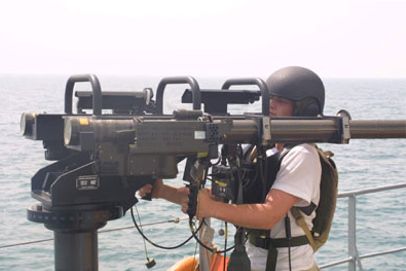
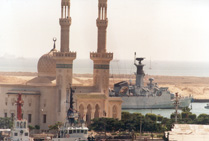
_SVN.jpg)
